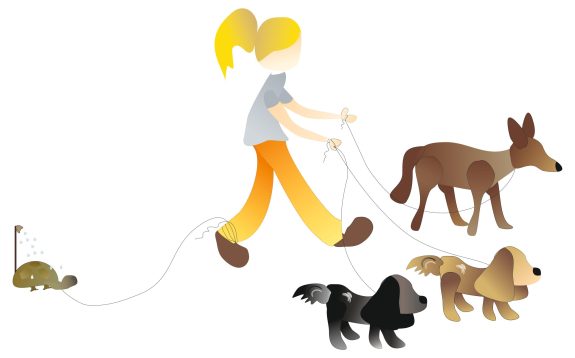
Washing and nail trimming, exercise and scaling teeth. What wouldn’t you give to have help with your dogs, especially if you have several?
Back in the day, showing a dog was a wealthy person’s sport, and it wasn’t a mystery why the well heeled always seemed to have big winning dogs. They not only could afford to buy quality dogs, they bred them at a frequency that would be vilified today. One other thing: The rich had big kennels that housed a lot of dogs. By way of illustration, we point to Geraldine Rockefeller Dodge who kept around 150 dogs at her Giralda Farms estate in New Jersey, and reportedly spent $55,000 a year to feed them. Having kennel help wasn’t a luxury for these fanciers, it was a necessity. To that end, kennels had staff that typically included a “kennel master” who saw to it that every dog was kept healthy, exercised and well fed. But he or she couldn’t do it alone, either. Enter the kennel maid.
These young ladies performed chores that would ring familiar to anyone who has been the assistant to a professional handler, but unlike today’s kennel help who gets on-the-job-training, there were actual schools for kennel-maids in the United Kingdom where students wore uniforms, and learned their trade in a classroom setting,
We don’t have permission the share the various historic photos of kennel maids, but you can see them by clicking on the hyperlinks below:
••• Helmeted kennel Maids working for the Blue Cross during WWII cared for dogs belonging to WWII soldiers;
••• This one was taken around 1934 at Ardross Kennels. An interesting side note is that many of the kennel maids such as those seen in this photo went on to become uniformed members of the Women Auxiliary Territorial Service which trained dogs for Great Britain’s first war dog training program at the Greyhound Racing Kennels near Potter’s Bar. Many of the dogs were Airedales, a fact credited to Lt Col Edwin Hautenville Richardson who had demonstrated in the run-up to World War One that dogs – and Airedale Terriers in particular, could be trained to carry messages, locate injured men, and serve as sentries. Richardson said of the breed, “They’re very determined. They’re very single-minded, and there’s no stopping them;”
••• This photo from 1927 was taken at the old Bellmead Kennels founded by Jane Trefusis Forbes (yes, those are Dandie Dinmont Terriers);
••• As can be seen in this 43 second video, students often got as much or a work out at the dogs they exercised. A longer clip of kennel-maid students in Haslemere, England can be viewed here.
We had thought that the concept of a “kennel maid” was a quaint, but dated idea, so imagine our surprise when we came across a “wanted listing” for a kennel maid posted this year. The job description includes the position’s “primary purpose…to maintain the cleanliness of the kennels, kitchens, staff room and various surrounding areas.” If you’re keen to apply, or just curious, read the entire listing here.
We found it pays to be discerning when looking for more reading material on kennel maids. A 1958 issue of Sports Illustrated included, “The Case of the Crooked Kennelmaids,” a “murky tale of racing dogs and seven “wailing” young ladies trotted off to jail. We still don’t know if the story was fact or fiction.
Bona fide fiction is The Kennel Maid: A Day In The Life Of A Kennel Maid by by No Barking: A Story Of A Kennel Maid At An English Manor House,” by
And then there were clearly fictional pieces of work which tilt towards salaciousness, if you catch our drift. Buyer beware!
Image: “Animali domestici” by ph_gims from Adobe Stock photo service
